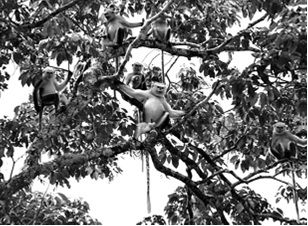

11/09/2017
Du Già National Park (NP) - Đồng Văn Karst Plateau about 30 km Northeast of Hà Giang city, is located in the location of three communes Tùng Bá (Vị Xuyên district); Minh Sơn (Bắc Mê district) and Du Già (Yên Minh district). The Du Già NP was established according to Decision No. 1377/2015/QD-TTg, based on the merging of the Du Già Nature Reserve and Khâu Ca Golden Snub-nosed Monkey Species and Landscape Area. This is an area of high biodiversity with many rare flora and fauna species such as golden snub-nosed money white cheeked gibbon, serow, bách xanh (Calocedrus macrolepis), bách xanh núi đá (Calocedrus rupestris), nghiến (Burretiodendron hsienmu), and đinh (Polyscias fruticose)...

Golden snub-nosed monkey in Du Già NP
Forest resources and biodiversity
Du Già NP that has an area located in the Đồng Văn Karst Plateau Geo-park has an area of 14,068.0 ha, making up 93.7% of the natural area. According to the Việt Nam vegetation classification system, the Du Già NP has five main forest vegetation types: low mountain tropical moist evergreen close forest in mountains of less than 700m; medium high mountain tropical moist evergreen close forest distributed at latitude of more than 700m; limestone tropical moist evergreen close forest; secondary vegetation types including secondary forests that were rehabilitated after exploitation and farming; some supporting vegetation such as bamboo forests, plantations (pine, acacia) and shrubs, timber trees…
The flora system of the NP has 1,061 vascular plant species, belonging to 629 genus, 202 families and six phyla. In other words, out of seven vegetation phyla identified to be distributed in Việt Nam, the Du Già NP has six phyla, making up 85.71% of the phyla. The most diverse phylum is Magnoliophyta with 950 species (contributing 89.54%), followed by Polypodiophyta with 88 species (accounting for 8.29%), Pinophyta with 12 species (making up 1.13%), Lycopodiophyta with nine species (0.85%), the remaining belongs to Psilotales and Equisetophyta, each phylum has one species. In addition, the diversity is also shown in the number of identified families which is 202, making up 53.44% of the total families of the Việt Nam flora system, of which 29 families have high number of species (accounting for 56.08%) such as Orchidaceae with 65 species (6.13%); followed by Euphorbiaceae with 46 species (4.34%); Rubiaceae with 45 species (4.24%); Moraceae with 39 species (3.68%); Asteraceae with 33 species (3.11%); Lauraceae with 26 species (2.45%); Fabaceae and Verbenaceae with 25 species each (2.36%); Araceae with 22 species (2.07%); Rutaceae with 17 species (1.60%) and followed by the remaining 19 families.
Terrestrial vertebrate fauna system in the NP, according to statistics, has 318 species belonging to 77 families, 24 orders. Of which mammals has 72 species in 22 families, eight orders; avian system has 162 species in 37 families, 12 orders; amphibians and reptiles have 84 species in 18 families, four orders. Of 318 fauna species, there are 35 rare species, particularly the golden snub-nosed monkey which is one of 25 primates that are being significantly prone to extinction in the world. They are categorised as "critically endangered - CR" in both Vietnam Red Book (2007) and the IUCN Red Book (2015). Golden snub-nosed monkey is a narrow endemic species, it only distributes in some area in the Northeast of Việt Nam. Currently, the golden snub-nosed monkey population is only between 108 - 113, making up nearly 50% of the current total number of golden snub-nosed monkey in Việt Nam.
In addition, 13 reptiles and amphibians are classified as rare (accounting for 15% of identified species) including 12 national threatened species, listed in the Vietnam Red Book (2007); five species at VU - vulnerable (Chinese water dragon, gecko, radiated ratsnake, impressed tortoise, and softshell turtle), seven species at EN - endangered (Chinese ratsnake, banded krait, Chinese cobra, big headed turtle, tonkin Asian frog, giant spiny frog and Vietnamese mossy frog).
Potential for ecotourism development
With cool climate and magnificent mountain landscape, there are potentials for tourism routes and spots and rest stops for tourists to view rare flora species, ancient trees, and wild fauna species in the NP. The NP has Ba Tiên mountain range with 25 small and large peaks and Đèo Gió area located in the provincial road No.176 located in Yên Minh district, has the potential for ecotourism and adventure tourism.
In addition to magnificent natural landscape and biodiversity, the Mông, Dao, Tày... people communities also maintain traditional cultural beauty such as: Cap sac festival, new rice praying festival, season praying festival, Gau Tao festival, dancing new year, fair, love market… In this area, tourists can see the colours of brocade costumes and the echo of gong and dances. Special traditional cultural values of these people are valuable non-material cultural values, which are humanity resources to be exploited for humanity ecological tourism development in the NPn
Tạ Kiều Anh
Biodiversity Conservation Agency
Vietnam Environment Administration